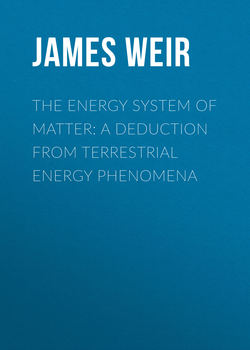Читать книгу The Energy System of Matter: A Deduction from Terrestrial Energy Phenomena - James Weir - Страница 17
PART II
PRINCIPLES OF INCEPTION
15. Cohesion as an Incepting Influence
ОглавлениеOther aspects of incepting energy may be derived from the examples cited above. Returning to the case of the rotating copper sphere, let it be assumed that in consequence of its rotation in the magnetic field it is raised from a low to a high temperature. Due to the heating effect alone, the mass will expand or increase in volume. This increase is the evidence of a definite energy process by which certain particles or portions of the mass have in distortion gained energy of position—energy of separation—or potential energy relative to the centre of the sphere. In fact, if the mass were allowed to cool back to its normal condition, this energy might by a suitable arrangement be made available for some form of external work. It is obvious, however, that this new energy of position or separation which has accrued to the mass in its heated condition has in reality been obtained by the transformation of the "work" energy originally applied. The abnormal displacement of certain particles or portions of the mass from the centre of the sphere is simply the external evidence of their increased energy. Now this displacement, or strain, due to the heat expansion, is carried out against the action of certain cohesive forces or stresses existing between the particles throughout the mass. These cohesive forces are, in fact, the agency which determines this transformation of heat into energy of position. Their existence is essential to the process. But these cohesive forces are simply the external manifestation of that energy by virtue of which the mass tends to maintain its coherent form. They are the symbol of that energy which might be termed the cohesion energy of the mass—they are, in fact, the symbol of the incepting energy influence of the transformation. This incepting energy influence of cohesion is one which holds sway throughout all solid material. It is, therefore, found in action in every movement involving the internal displacement or distortion of matter. It is a property of matter, and accordingly it is found to vary not only with the material, but also with the precise physical condition or the energy state of the material with which it is associated. In this respect, it differs entirely from the preceding magnetic influence. The latter, we have seen, has no direct association with the copper ball, or with the material which is the actual venue of the transformation. As an energy influence, it is itself persistent, and unaffected by the energy state of that material. On the other hand, the cohesion energy, being purely a property of the material which is the habitat of the energy process, is directly affected by its energy state. This point will be clearer by reference to the actual phenomena of the heat transformation. As the process proceeds, the temperature of the mass as the expansion increases will rise higher and higher, until, at a certain point, the solid material is so energised that change of state ensues. At this, the melting-point of the material, liquefaction takes place, and its cohesive properties almost vanish. In this fashion, then, a limit is clearly imposed on the process of heat transformation in the solid body—a limit defined by the cohesive or physical properties of the particular material. In this limiting power lies the difference between cohesion and magnetism as incepting influences. Looking at the whole dynamo-electric transformation in a general way, it will be clear that the magnetic influence in no way limits or affects the amount of dynamical or "work" energy which may be applied to the rotating sphere. This amount is limited simply by the cohesive properties of the material mass in rotation. The magnetic influence might, in fact, be regarded as the primary or inducing factor in the system, and the cohesion influence as the secondary or limiting factor.
